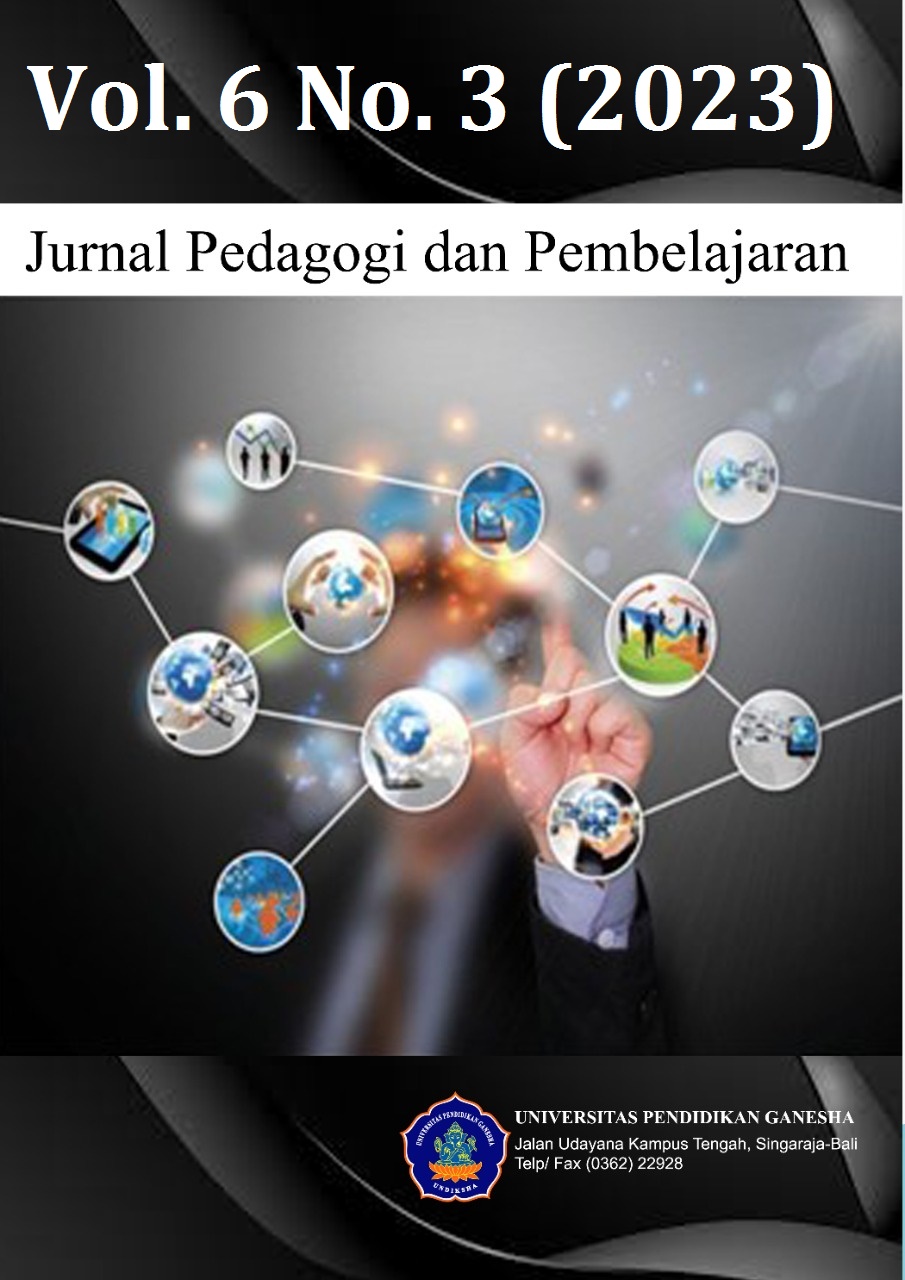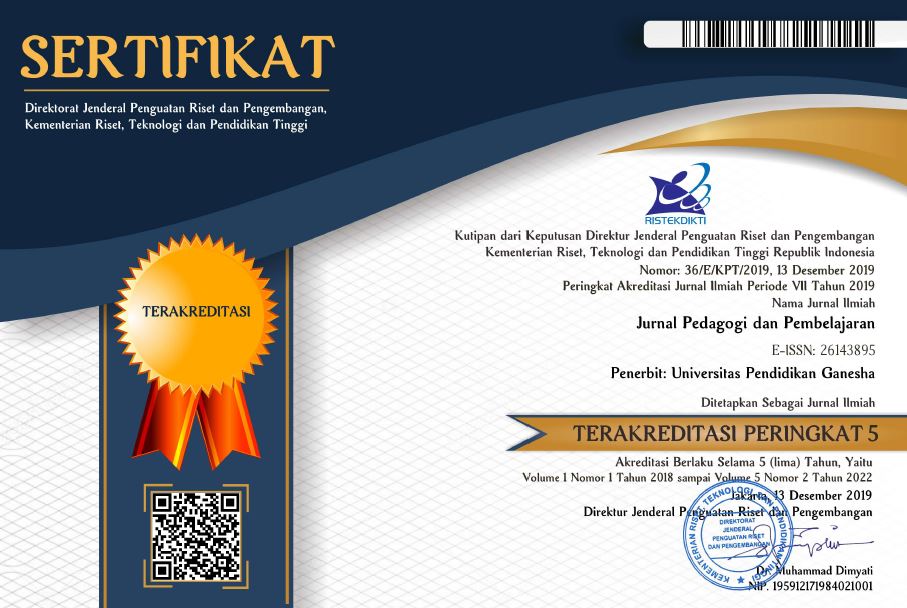Problem Based Learning Model Based on Tat Twam Asi for Understanding Natural Science Concepts
DOI:
https://doi.org/10.23887/jp2.v6i3.64944Kata Kunci:
Problem Based Learning, Tat Twam Asi, Understanding Science ConceptsAbstrak
Science can be a provision for students to face various challenges in the global era. This research aims to test the effect of the Problem-Based Learning (PBL) learning model based on Tat Twam Asi on the understanding of science concepts for class V students. This research is a quasi-experimental research with a non-equivalent post-test-only control group design. The population in this study were all class V students. The sample for this study used a simple random sampling technique. The sample for this research was 36 students as the experimental group. Research data was collected using the test method with objective test instruments to measure understanding of science concepts. The data obtained were analyzed using descriptive and inferential statistics (t-test). The results of the research show that there is a difference in understanding of science concepts between students who follow the Problem-Based Learning (PBL) learning model based on Tat Twam Asi and students who do not follow the Problem-Based Learning (PBL) learning model based on Tat Twam Asi in class V. It is known that The Tat Twam Asi-based Problem Based Learning (PBL) learning model has a significant influence on fifth-grade students' understanding of science concepts.
Referensi
Ahmad, & Muslimah. (2021). Understand Qualitative Data Processing and Analysis Techniques. Proceedings, 1(1), 173–186.
Amen, A. (2017). Development of teaching materials for moral aspects based on a democratic learning approach in increasing students' understanding of concepts at SMPN 12 Bengkulu City. MANHAJ: Journal of Research and Community Service, 6(3). https://doi.org/10.1161/.v5i3.755.
Anggraeni, NPLA, & PF, KAPD (2018). Dolanan as a Character Education Media for Elementary School Students. Adi Widya: Journal of Basic Education, 3(1), 1–6. https://doi.org/10.25078/aw.v3i1.900. DOI: https://doi.org/10.25078/aw.v3i1.900
Anggraeni, WS, Alpian, Y., Prihamdani, D., & Winarsih, E. (2021). Development of Video-Based Interactive Learning Multimedia to Increase Elementary School Students' Interest in Learning. Basicedu Journal, 5(6), 5313–5327. https://doi.org/10.31004/BASICEDU.V5I6.1636. DOI: https://doi.org/10.31004/basicedu.v5i6.1636
Anzar, SF, & Mardhatillah. (2017). Analysis of Students' Learning Difficulties in Learning Indonesian in Class V of SD Negeri 20 Meulaboh, West Aceh Regency, 2015/2016 Academic Year. Bina Gogik, 4(1 March 2017), 53–64.
Astuti, T.P. (2019). Problem based learning model with mind mapping in 21st century science learning. Proceedings of Biology Education, 3(1), 64–73. https://doi.org/10.21009/pbe.3-1.9. DOI: https://doi.org/10.21009/pbe.3-1.9
Dwi, IM, Arif, H., & Sentot, K. (2013). The influence of ICT-based problem based learning strategies on conceptual understanding and physics problem solving abilities. Indonesian Journal of Physics Education, 9(1), 8–17. https://doi.org/10.15294/jpfi.v9i1.2575.
Fadillah, S., Fauzi, KMA, & Yus, A. (2020). The Effect of Problem Based Learning Model on Students' Mathematical Representation Ability and Student Adversity Quotient at SD Islam Setia Nurul Azmi Medan. Budapest International Research and Critics in Linguistics and Education (BirLE) Journal, 3(3), 1456–1467. https://doi.org/10.33258/birle.v3i3.1214. DOI: https://doi.org/10.33258/birle.v3i3.1214
Hanifah, H., Supriadi, N., & Widyastuti, R. (2019). The Influence of the E-learning Learning Model Assisted by Edmodo Learning Media on Students' Mathematical Problem Solving Ability. NUMERICAL: Journal of Mathematics and Mathematics Education. https://doi.org/10.25217/numerical.v3i1.453. DOI: https://doi.org/10.25217/numerical.v3i1.453
Haqiqi, AK (2019). Review of the implementation of the 2013 curriculum: review of the learning implementation plan (RPP) for natural science subjects. Journal of Natural Science and Integration, 2(1), 12–18. https://doi.org/10.24014/jnsi.v2i1.7110. DOI: https://doi.org/10.24014/jnsi.v2i1.7110
Helmi, J. (2016). Application of Silberman Concepts in the Lecture Method in PAI Learning. AL-ISHLAH: Journal of Education, 8(2), 221–245. https://doi.org/10.35445/alishlah.v8i2.20.
Hendriana, E.C., & Jacobus, A. (2017). Implementation of character education in schools through example and habituation. JPDI (Indonesian Journal of Basic Education), 1(2), 25–29. https://doi.org/10.26737/jpdi.v1i2.262. DOI: https://doi.org/10.26737/jpdi.v1i2.262
Hendriana, H., Johanto, T., & Sumarmo, U. (2018). The role of problem-based learning to improve students' mathematical problem-solving ability and self-confidence. Journal on Mathematics Education, 9(2), 291–299. https://doi.org/10.22342/jme.9.2.5394.291-300. DOI: https://doi.org/10.22342/jme.9.2.5394.291-300
Imelda, Cahyono, BY, & Astuti, UP (2019). Effect of process writing approach combined with video-based mobile learning on Indonesian EFL learners' writing skills across creativity levels. International Journal of Instruction, 12(3), 325–340. https://doi.org/10.29333/iji.2019.12320a. DOI: https://doi.org/10.29333/iji.2019.12320a
Irwandani, I. (2015). The influence of the generative learning model on the understanding of physics concepts on the subject of sound at MTs Al-Hikmah Bandar Lampung students. Al-Biruni Scientific Journal of Physics Education, 4(2), 165–177. https://doi.org/10.24042/jipfalbiruni.v4i2.90. DOI: https://doi.org/10.24042/jpifalbiruni.v4i2.90
Januarysman, E., & Ghufron, A. (2016). Development of web-based learning media for natural science subjects for class VII students. Journal of Educational Technology Innovation, 3(2), 166–182. https://doi.org/10.21831/jitp.v3i2.8019. DOI: https://doi.org/10.21831/jitp.v3i2.8019
Lestari, N., Anjarini, T., & Ngazizah, N. (2022). Development of Scapbook Media Based on Problem Solving on Plant Structure Material. UNMA FKIP Education Journal, 8(2), 491–497. https://doi.org/10.31949/educatio.v8i2.2220. DOI: https://doi.org/10.31949/educatio.v8i2.2220
Lestari, Y. (2018). Instilling the value of caring for the environment in natural science learning. Trihayu: Journal of Elementary School Education, 4(2). https://doi.org/10.30738/trihayu.v4i2.2238.
Liu, Y., & Pásztor, A. (2022). Effects of Problem-Based Learning Instructional Intervention on Critical Thinking in Higher Education: A Meta-Analysis. Thinking Skills and Creativity, 45, 1–21. https://doi.org/10.1016/j.tsc.2022.101069. DOI: https://doi.org/10.1016/j.tsc.2022.101069
Mukholifah, M., Tisngati, U., & Ardhyantama, V. (2020). Developing Character Puppet Learning Media in Thematic Learning. Journal of Research Innovation, 1(4), 673–682. https://doi.org/10.47492/jip.v1i4.152. DOI: https://doi.org/10.47492/jip.v1i4.152
Ni'mah, A., & Dwijananti, P. (2014). Application of the think pair share (TPS) learning model with experimental methods to improve learning outcomes and learning activities for class VIII MTs students. Nahdlatul Muslimin Kudus. UPEJ Unnes Physics Education Journal, 3(2). https://doi.org/10.15294/upej.v3i2.3593.
Nomleni, FT, & Manu, TSN (2018). Development of audio visual media and teaching aids to improve understanding of concepts and problem solving. Scholaria: Journal of Education and Culture, 8(3), 219–230. https://doi.org/10.24246/j.js.2018.v8.i3.p219-230. DOI: https://doi.org/10.24246/j.js.2018.v8.i3.p219-230
Nugraha, DA, Dimas, A., C., C., Suparmi, A., & Sunarno, W. (2019). Meta Analysis of the Influence of the POE Learning Model on Concept Understanding. Proceedings of SNFA (National Seminar on Physics and its Applications), 4, 174–179. https://doi.org/10.20961/prosidingsnfa.v4i0.37768. DOI: https://doi.org/10.20961/prosidingsnfa.v4i0.37768
Permana, MS, & Damiri, DJ (2014). Development of Multimedia-Based Interactive Learning Media for Natural Sciences (IPA). Journal of Algorithms, 11(2), 254–263. https://doi.org/10.33364/algoritma/v.11-2.254. DOI: https://doi.org/10.33364/algoritma/v.11-2.254
Prahesti, SI, & Fauziah, S. (2021). Application of Interactive Learning Media for Local Wisdom in Semarang Regency. Obsession Journal: Journal of Early Childhood Education, 6(1), 505–512. https://doi.org/10.31004/obsession.v6i1.879. DOI: https://doi.org/10.31004/obsesi.v6i1.879
Pratama, RA, & Saregar, A. (2019). Development of scaffolding-based student worksheets (LKPD) to practice understanding concepts. Indonesian Journal of Science and Mathematics Education, 2(1), 84–97. https://doi.org/10.24042/ijsme.v2i1.3975. DOI: https://doi.org/10.24042/ijsme.v2i1.3975
Rahayu, R., & FX, EWL (2015). Development of science learning tools based on problem based learning in junior high schools. Educational Journal of Learning Innovation Research, 45(1). https://doi.org/10.21831/jk.v45i1.7184.
Rahman, MM (2013). The Role of Parents in Building Self-Confidence in Early Childhood. Edukasia: Journal of Islamic Education Research, 8(2). https://doi.org/10.21043/edukasia.v8i2.759. DOI: https://doi.org/10.21043/edukasia.v8i2.759
Ramadhan, I. (2021). The use of problem based learning methods in increasing student learning activity in class XI IPS 1. Journal of Educational Sciences, 4(3), 358–369. https://doi.org/10.37329/cetta.v4i3.1352. DOI: https://doi.org/10.37329/cetta.v4i3.1352
Saputra, MEA, & Mujib, M. (2018). Effectiveness of the Flipped Classroom Model Using Mathematics Learning Videos on Concept Understanding. Decimal: A Journal of Mathematics, 1(2), 173–179. https://doi.org/10.24042/djm.v1i2.2389. DOI: https://doi.org/10.24042/djm.v1i2.2389
Septia, YL, Nurcahyono, NA, & Balkist, PS (2022). Development of Android-based beret media to improve vocational school students' ability to understand mathematical concepts. Scholar's Journal: Journal of Mathematics Education, 6(1), 35–47. https://doi.org/10.31004/cendekia.v6i1.986. DOI: https://doi.org/10.31004/cendekia.v6i1.986
Suari, NP (2018). Application of the problem based learning model to increase motivation to learn science. Elementary School Science Journal, 2(3), 241–247. https://doi.org/10.23887/jisd.v2i3.16138. DOI: https://doi.org/10.23887/jisd.v2i3.16138
Suastini, NN, & Suarjaya, IKBR (2021). Understanding the Teachings of Tat Twam Asi as a Guide in Efforts to Increase Self-Awareness in the Covid-19 Pandemic Era. Journal of Quality Assurance, 7(2).
Suhendar, U., & Ekayanti, A. (2018). Problem based learning as an effort to increase students' understanding of concepts. Journal of Dimensions of Education and Learning, 6(1), 15–19. https://doi.org/10.24269/dpp.v6i1.815. DOI: https://doi.org/10.24269/dpp.v6i1.815
Vashti, T.A., Hairida, H., & Hadi, L. (2020). Description of students' scientific literacy abilities in natural science subjects. EduChem, 1(2). https://doi.org/10.26418/educhem.v1i2.41108. DOI: https://doi.org/10.26418/educhem.v1i2.41108
Yuliana, N. (2018). Use of the Discovery Learning Learning Model in Improving Student Learning Outcomes in Elementary Schools. Scientific Journal of Education and Learning, 2(1), 21–29. https://doi.org/10.23887/jipp.v2i1.13851. DOI: https://doi.org/10.23887/jipp.v2i1.13851
Yulianti, E., & Gunawan, I. (2019). Problem based learning (PBL) learning model: Its effect on understanding concepts and critical thinking. Indonesian Journal of Science and Mathematics Education, 2(3), 399–408. https://doi.org/10.24042/ijsme.v2i3.4366. DOI: https://doi.org/10.24042/ijsme.v2i3.4366
Yuliati, Y., & Lestari, I. (2019). Application of the Creative Problem Solving model to improve student learning outcomes in Natural Sciences learning in elementary schools. Pendas Cakrawala Journal, 5(1). https://doi.org/10.31949/jcp.v5i1.1200. DOI: https://doi.org/10.31949/jcp.v5i1.1200
Zaini, H., & Dewi, K. (2017). The Importance of Learning Media for Early Childhood. Raudhatul Athfal: Journal of Early Childhood Islamic Education, 1(1). https://doi.org/10.19109/ra.v1i1.1489. DOI: https://doi.org/10.19109/ra.v1i1.1489
Unduhan
Diterbitkan
Cara Mengutip
Terbitan
Bagian
Lisensi
Hak Cipta (c) 2023 I Made Sujana, Sujana

Artikel ini berlisensiCreative Commons Attribution-ShareAlike 4.0 International License.
Authors who publish with Jurnal Pedagogi dan Pembelajaran agree to the following terms:- Authors retain copyright and grant the journal the right of first publication with the work simultaneously licensed under a Creative Commons Attribution License (CC BY-SA 4.0) that allows others to share the work with an acknowledgment of the work's authorship and initial publication in this journal
- Authors are able to enter into separate, additional contractual arrangements for the non-exclusive distribution of the journal's published version of the work (e.g., post it to an institutional repository or publish it in a book), with an acknowledgment of its initial publication in this journal.
- Authors are permitted and encouraged to post their work online (e.g., in institutional repositories or on their website) prior to and during the submission process, as it can lead to productive exchanges, as well as earlier and greater citation of published work. (See The Effect of Open Access)










